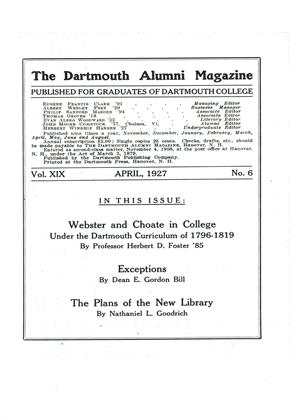Training in Citizenship. By Roy Winthrop Hatch '02. Charles Scribner's Sons, New York, 1926.
Recent educational tendencies have been given fair expression in Mr. Hatch's Training inCitizenship a description of the work in Horace Mann School. For the past forty years Horace Mann School of New York City as the educational laboratory of Teachers College, Columbia University, has been among the leading experimenters in education in the United States. To anyone interested in educational methods the instruction at Horace Mann has a great interest.
For a considerable length of time such ideas as the socialized recitation, the project method, improved examinations, and the use of extracurricular activities for educational purposes, have been of exceedingly great interest to educators. In consequence, we feel thankful to Mr. Hatch for giving us specifically and in detail the methods employed at Horace Mann in History and Civics. Not only is new light thrown upon these methods, but there are also many specific suggestions which should be of great value to teachers all over the country. Additional aid is given by the many references which appear throughout the book.
Nothing stands out more clearly in the book than Mr. Hatch's own ability. From the stenographic report (pp. 304-316) of a meeting of his class, we are pretty well convinced that the teaching would be effective whether done from the front of the room, as in the usual manner, or from a seat in the class, which is actually the way the work is done. There certainly can be little quarrel with Mr. Hatch in his emphasis upon the proper mental traits and habits of thought, instead of upon the acquisition of soon-to-be-forgotten facts; we can only wish that in the early part of the book there had been a little more emphasis upon the search for truth rather than upon such traits as courtesy, punctuality and cleanliness.
The book is composed largely of articles and addresses which have been printed in other places. A few of these articles were not written by Mr. Hatch. Taken together, we must compliment the author upon the general organization of the book and the lack of repetition. Now and then, however, one feels a slight lack of unity, while in a few cases there is obvious repetition; for example, the paragraph on pp. 218-9 is a word for word reproduction of a paragraph on pp. 146-7.
It is to be hoped that Mr. Hatch's book has a wide sale. For all teachers and parents it represents a valuable point of view, as well as giving a large number of very useful and practical teaching suggestions.
 View Full Issue
View Full Issue
More From This Issue
-
 Article
ArticleWEBSTER AND CHOATE IN COLLEGE
April 1927 By Herbert Darling Foster '85 -
 Lettter from the Editor
Lettter from the EditorEditorial Comment
April 1927 -
 Article
ArticlePRESIDENT HOPKINS SUGGESTS FOOTBALL MODIFICATIONS
April 1927 -
 Article
ArticleEXCEPTIONS
April 1927 By E. Gordon Bill -
 Class Notes
Class NotesClass of 1921
April 1927 By Herrick Brown -
 Sports
SportsDARTMOUTH QUINTET WINS FIRST LEAGUE CHAMPIONSHIP
April 1927
Robert E. Riegel
-
 Books
BooksMAKE EVERYBODY RICH
FEBRUARY 1930 By Robert E. Riegel -
 Article
ArticleTHE DAY OF THE CATTLEMAN
MARCH 1930 By Robert E. Riegel -
 Article
ArticleA College Course for Alumni
January, 1931 By Robert E. Riegel -
 Books
BooksTHE DECLINE OF AMERICAN LIBERAL-
April 1956 By ROBERT E. RIEGEL -
 Books
BooksARTISTS OF THE OLD WEST.
JANUARY 1968 By ROBERT E. RIEGEL -
 Books
BooksAMERICAN HEROINE: THE LIFE AND LEGEND OF JANE ADDAMS
October 1973 By ROBERT E. RIEGEL
Books
-
 Books
BooksAlumni Articles
APRIL 1965 -
 Books
BooksSECOND WIFE.
DECEMBER 1963 By CLIFF JORDAN '45 -
 Books
BooksMISSION IN TORMENT: AN INTIMATE ACCOUNT OF THE U.S. ROLE IN VIETNAM.
JULY 1965 By ERNEST P. YOUNG -
 Books
BooksECONOMIC PRINCIPLES IN PRACTICE
June 1939 By G. W. Woodworth -
 Books
BooksTO THE GREAT OCEAN.
FEBRUARY 1966 By JOHN C. ADAMS -
 Books
BooksEARLY AMERICAN ARCHITECTURE
May 1952 By Mark L. Peisch '44


